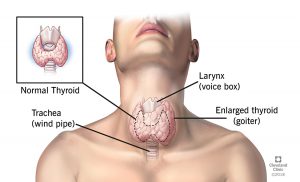Last month in our two-part series exploring how the thyroid gland affects vision, we looked at hyperthyroidism. This month, we will look at hypothyroidism.
To recap, the thyroid is essentially your body’s hormone factory. Shaped like a butterfly, it’s found in the lower front of your neck, just below your Adam’s apple. The hormones, which are secreted into your bloodstream, regulate how fast or slow your body functions.
Hyperthyroidism is a condition that happens when the immune system attacks the thyroid gland. This leads to inflammation, causing the thyroid to produce too much hormone in response, speeding everything up. Over time, according to the Mayo Clinic, this overactivity ends up damaging the gland and preventing it from producing enough hormones. This is called hypothyroidism and is also known as Hashimoto’s disease.
What is Hypothyroidism?
In cases where your gland is operating sluggishly, you may notice the following symptoms: tiredness, weight gain, cold intolerance, joint and/or muscle pain, constipation, dry or thinning hair, depression, memory loss, and slowed heart rate. For women, periods may become heavy. Additionally, in hypothyroidism, the gland itself can become enlarged, giving an appearance of a bulge in the neck, and you may have a feeling of fullness in your throat as a result. This enlargement is called a goiter. Finally, hypothyroidism can contribute to high levels of cholesterol, so if you are experiencing the symptoms related to hypothyroidism, it’s important to have that checked as well.
How Does it Affect the Eyes?
In last month’s post, we talked about Grave’s disease in relation to the eyes (named after the doctor who discovered it). With Grave’s disease, there are several characteristics that include dry eyes, bulging eyes, difficulty closing eyelids, and increased pain/pressure behind the eye. With Hashimoto’s — or Thyroid-associated Eye Disease (TED) — there’s all this, and more. (Think of Grave’s disease as the condition that starts the motor running at full speed, and Hashimoto’s disease as the one that burns it out due to overuse.) Hashimoto’s/TED takes it several steps further by adding on blurry vision, puffy eyes (also known as periorbital swelling), and loss of eyelash and eyebrow hairs to the list of symptoms.
Both hyperthyroidism and hypothyroidism, if left untreated, could lead to the cornea ulcerating, causing cataracts and perhaps even vision loss.
In rare cases, the long-term swelling of the eyes can lead to compression on the optic nerve itself, causing abnormal color vision, lights appearing dimmer, and a diminishing of vision clarity or sharpness. Again, while these symptoms are rare, it’s helpful to know what they are if you’ve been diagnosed with hypothyroidism.
Treatment
Did you know that getting a comprehensive eye exam every year can help to identify the early stages of many diseases? Where the thyroid is concerned, early detection and treatment of hyperthyroidism will help to prevent hypothyroidism from developing. Of course, treating your overactive thyroid will involve working with your primary care physician as well and may include medication or hormone replacement to control the thyroid.
For More Information
If you suspect that you may have a thyroid issue, here are the sources used in putting together this two-part series:


